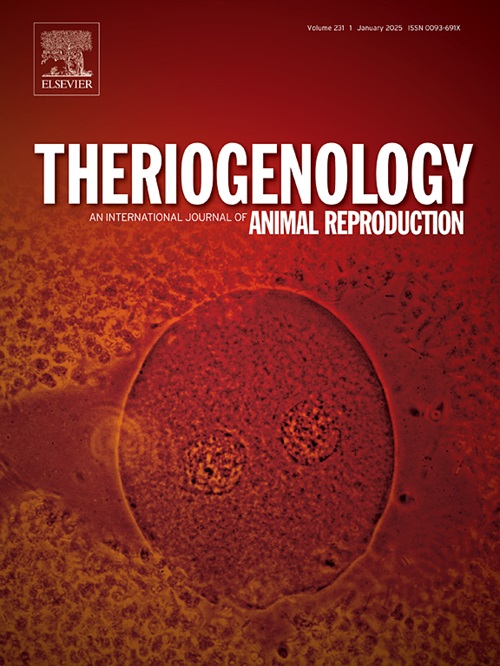PPARG 对山羊颗粒细胞增殖、凋亡和雌激素分泌的影响
IF 2.4
2区 农林科学
Q3 REPRODUCTIVE BIOLOGY
引用次数: 0
摘要
作为过氧化物酶体增殖激活受体(PPAR)家族的成员,PPARG 被报道在不同物种中参与糖脂代谢。然而,PPARG 在山羊卵巢颗粒细胞(GCs)雌二醇(E2)合成、凋亡和增殖中的功能尚不清楚。本研究发现,山羊 PPARG 在各级卵泡的 GCs 中均有表达,并且定位于 GCs 的细胞质和细胞核中。转染小干扰 RNA-PPARG2(si-PPARG2)可减少 E2 的合成以及 HSD3B 和 CYP19A1 mRNA 和蛋白的丰度。它还能促进细胞凋亡,显著增加 BAX/BCL-2 和 Caspase3 mRNA 和蛋白的比例。同时,细胞周期受到 si-PPARG2 转染的抑制,CDK4、CKD6、MYC、CCND1、CCND2、PCNA 和 CCNB 的 mRNA 水平降低,P53 的 mRNA 水平升高,CDK4、MYC 和 CCND1 的蛋白水平降低。此外,PPARG干扰影响了CREB的mRNA和蛋白丰度以及CREB的磷酸化,但不影响PKA。总之,我们的数据表明,PPARG 在调节山羊 GCs 的 E2 合成、细胞凋亡和增殖(包括 CREB 的表达和磷酸化)方面起着重要作用。这些结果为深入研究 PPARG 在山羊 GCs 功能调控中的作用提供了证据。本文章由计算机程序翻译,如有差异,请以英文原文为准。
Effects of PPARG on the proliferation, apoptosis, and estrogen secretion in goat granulosa cells
As a member of peroxisome proliferator-activated receptor (PPAR) family, PPARG has been reported to be involved in glucolipid metabolism in various species. However, the function of PPARG in estradiol (E2) synthesis, apoptosis, and proliferation in goat ovarian granulosa cells (GCs) is unclear. In this study, we found that goat PPARG was expressed in GCs of all grades of follicles, and localized in the cytoplasm and nucleus of GCs. Transfection of small interfering RNA-PPARG2 (si-PPARG2) decreased E2 synthesis and the abundances of HSD3B and CYP19A1 mRNA and protein. It also promoted cell apoptosis with significant increases in the ratio of BAX/BCL-2 and Caspase3 mRNA and protein. Meanwhile, cell cycle was inhibited by si-PPARG2 transfection, accompanied by decreased mRNA levels of CDK4, CKD6, MYC, CCND1, CCND2, PCNA, and CCNB, increased mRNA level of P53, and decreased protein levels of CDK4, MYC, and CCND1. Furthermore, PPARG interference affected the mRNA and protein abundances of CREB as well as the phosphorylation of CREB but not PKA. In conclusion, our data suggest that PPARG plays an important role in regulating E2 synthesis, cell apoptosis, and proliferation of goat GCs, including the CREB expression and phosphorylation. These results provide evidences for the in-depth study of PPARG in the regulation of goat GCs function.
求助全文
通过发布文献求助,成功后即可免费获取论文全文。
去求助
来源期刊

Theriogenology
农林科学-生殖生物学
CiteScore
5.50
自引率
14.30%
发文量
387
审稿时长
72 days
期刊介绍:
Theriogenology provides an international forum for researchers, clinicians, and industry professionals in animal reproductive biology. This acclaimed journal publishes articles on a wide range of topics in reproductive and developmental biology, of domestic mammal, avian, and aquatic species as well as wild species which are the object of veterinary care in research or conservation programs.
 求助内容:
求助内容: 应助结果提醒方式:
应助结果提醒方式:


